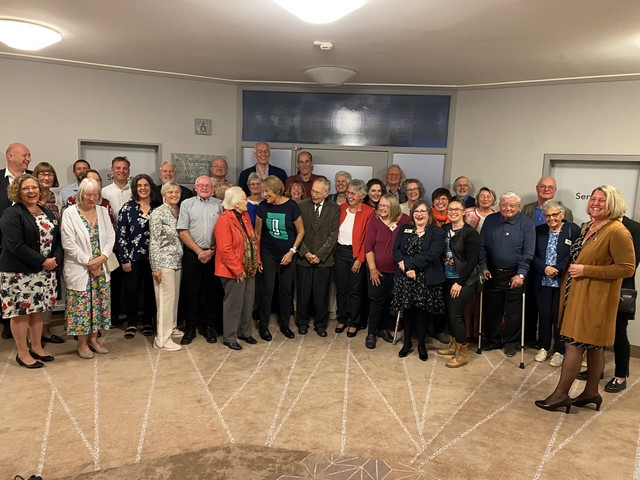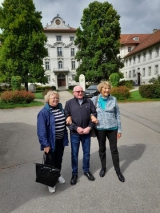Gill James – Secretary St Helier/ Bad Wurzach Partnerschaft

2022 has been a memorable year for many reasons but it holds especial meaning for 2 towns in different countries linked by a moment in history. Recently a group of people returned from visiting Bad Wurzach in Southern Germany, a town which has unique links with St Helier and Jersey.
When, during the Occupation, in September 1942, 620 islanders were deported to Bad Wurzach , they could have no idea that 80 years later we would still be commemorating that event; or indeed that in the future we would be so closely linked by friendship that a formal twinning group or “Partnerschaft” would be established between Bad Wurzach and St Helier in 2002 – this year also marks 20 years of Partnerschaft.
The reason for the deportations was as a reprisal for the Allies interning German civilians in Iran and on the direct orders of Hitler. The 620 internees were men, women and children, some born in Britain, many born in Jersey, of all ages, from babes in arms to the elderly. After three days travelling by boat to St Malo and train through France, Belgium, Luxembourg and Germany, and weeks at Biberach , a camp not far from Bad Wurzach, they finally arrived and were marched from the station, through the town to their internment camp in the Schloss (more like a stately home or mansion than a castle) where they would spend the next almost three years. The local townspeople were shocked that women and children were in the group and so many of them did all they could to help the internees with food and many other acts of kindness. In fact, when the camp was liberated in April 1945, the internees owed their lives to the people of the town who warned the Free French liberators that there were British people in the castle and not Germans (thinking it was a Nazi HQ they were going to shell it.) In return the internees explained to the Free French that the townspeople had been very kind to them. Perhaps this was the beginning of the subsequent friendship and Partnerschaft which exists today and perhaps accounts for its uniqueness amongst our Island’s many twinning groups.
People have been making informal journeys to and from Bad Wurzach from the 70s onwards and from small beginnings the Partnerschaft has burgeoned with exchanges of students, musical and youth groups, the establishment of bursaries and visits between each town and the hospitality shown to each group by the other is legendary. Covid put paid to the last planned visit in 2018 so this year was all the more special.
Our group consisted of three internees – Lola Garvin from the St Helier Partnerschaft who organised the trip, Roy Newton and Angela Thom who was born in Bad Wurzach. Also with us were relatives of the original internees and their families. We were accompanied by the Constable of St Helier, Simon Crowcroft and his wife Angela, and St Helier Deputy Mary Le Hegerat . At Heathrow we met up with some more relatives and when we arrived in Bad Wurzach we joined others who had travelled earlier, including two former Bailiffs and their wives and Angela Francey who, with the late Michael Ginns, was one of the founders of the Partnerschaft. Michael’s widow Josephine was also in our group and reporter Rod McLoughlin accompanied us to record the visit for the JEP, which he did admirably.
Our visit was memorable for many reasons. For many in both the St Helier and Bad Wurzach groups it was so good to reconnect and re – establish friendships after the last two plus years of Covid enforced separation. The welcome and hospitality shown to us from the German group was incredible and we enjoyed many informal gatherings as well as the more formal ceremonies. One memorable evening was a wonderful buffet prepared and served by the German group, who catered for around 75 people. Some of us particularly enjoyed the choice of puddings, going back for seconds! A very large chocolate cake decorated with the crests of both towns was ceremonially jointly cut by Simon and Frau Scherer the Mayor. We were entertained that evening by a very talented and enthusiastic group of young brass players. We also had organised visits to Lake Constance for a day trip to Mainau Island celebrated for its beautiful gardens, a guided walk around the local wetlands area – known as the Moor and a visit to the nearby town of Memmingen.
We were very well looked after by our German friends who organised everything, including ensuring that one of our groups who had walking difficulties received personal assistance and was able to enjoy our activities.
A highlight for most of us was the guided tour of the Schloss by Gisela Rothenhausler, a member of the German Partnerschaft and an expert historian who has written a book describing the history of Bad Wursach’s Schloss. She was able to show us the rooms where the internees lived during their years in the castle and although it has now been beautifully restored, we were able to imagine what it would have been like then. It was a very moving and emotional experience especially seeing those rooms that were used as hospital wards. We were so impressed with the restoration of the main entrance hall and staircase – adorned with murals of gods and goddesses in the Baroque style complete with carved marble columns. Apparently, it was called Marble Arch by the internees and used as a meeting place. It is now used for official civic occasions and wedding ceremonies. An official ceremony was organised for us so that Simon could sign the special Golden Book of Bad Wurzach reserved for important visitors to the town.
The more formal ceremonies were also very moving. A very special church service was held in the restored chapel attached to the Schloss, which was led by two Roman Catholic priests from Bad Wurzach and the Rev Dr Sarah McClelland, herself the daughter and granddaughter of internees. The service, which included hymns, prayers and readings, was conducted both in German and English and seemed to be a perfect symbol of the way our two communities have come together with friendship and mutual respect.
A more sombre ceremony was held in the town cemetery to commemorate those internees who did not return home at the end of the war but remain buried in Bad Wurzach. We gathered in front of the cemetery’s memorial wall, inscribed with the names of all those from Bad Wurzach who died in two world wars, and which includes the names of 11 internees. A wreath was laid jointly by Frau Scherer and Simon Crowcroft; readings were given on the theme of Hope by Lola Garvin an internee, Judy King, the daughter of an internee, and prayers were said by Rev Dr Sarah McClelland. After which white roses were laid on the gravestones as a mark of respect and remembrance. The cemetery is beautifully maintained and our section of it is immaculate. For those of our group whose family members lie here, this was especially moving.
One of our final events was the opening of a very special exhibition curated by Partnerschaft member and local historian, Gisela Rothenhausler, who has extensively researched the history of Bad Wurzach’ Schloss and its war time role as an internment camp. The exhibition consists of photographs taken of pictures and cards drawn and painted by the internees. The originals remain in the collection of Jersey Archive and due to their fragile state were unable to be transported so copies were made. They depict local scenes around the Schloss as well as everyday life inside it and are a vivid representation of the conditions and activities of the internees. There were many artists who recorded their experiences, the principal ones being Harold Hepburn and TS Webber whose daughter Angela Thom, was among our party. The exhibition is remaining open in Bad Wurzach for local townspeople to view it but it is hoped that soon it may travel to Jersey to be put on display here so that islanders can view it too and gain an impression of what life was like for the internees.
This visit was a wonderful experience for all of us – we were all overwhelmed by the kindness and friendship shown to us by the people of Bad Wurzach .The Partnerschaft has proved to be stronger than ever, and it seems an appropriate way forward in these uncertain times to encourage future interaction between our two communities. For me, personally as the granddaughter of internees and a first-time visitor, this has been an unforgettable experience and I look forward to future gatherings.
Gill James September 2022

